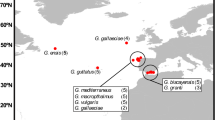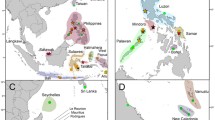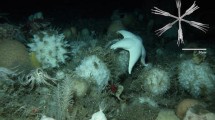Abstract
In the classical taxonomy, three Scomber species are distinguished: S. scombrus, S. australasicus, and S. japonicus. Yet, some fish taxonomists have recently recognized Scomber colias, inhabiting the Atlantic Ocean, as a separate species from S. japonicus, distributed in the Pacific Ocean. Such proposal was based on significant mitochondrial DNA divergence as well as great phenotypic variation among individuals from these two ocean basins. However, in the absence of nuclear DNA data this issue remains still controversial. In this study, a phylogenetic analysis of nuclear 5S rDNA sequences was performed. A total of 30 individuals of S. colias collected in the Atlantic and 34␣specimens of S. japonicus from the Pacific were characterized. Moreover, nine individuals of Pacific S.␣australasicus and eight of Atlantic S. scombrus were included. Maximum likelihood, maximum parsimony, and neighbor-joining analyses revealed the presence of␣two well-supported distinct clades corresponding to S. colias and S. japonicus, respectively. Altogether, morphologic and genetic data are in agreement with the recognition of two different species, S. colias in the Atlantic, and S. japonicus in the Pacific.
Similar content being viewed by others
References
Alvarado Bremer JR, Mejuto J, Baker AJ (1995) Mitochondrial DNA control region sequences indicate extensive mixing of swordfish (Xiphias gladius L.) populations in the Atlantic Ocean. Can J Fish Aquat Sci 52:1720–1732
Alvarado Bremer JR, Mejuto J, Greig TW, Ely B (1996) Global population structure of the swordfish (Xiphias gladius L.) as revealed by analysis of the mitochondrial DNA control region. J Exp Mar Biol Ecol 197:295–310
Alvarado Bremer JR, Naseri I, Ely B (1997) Orthodox and unorthodox phylogenetic relationships among tunas revealed by the nucleotide sequence analysis of the mitochondrial DNA control region. J Fish Biol 50:540–554
Alvarado Bremer JR, Stequert B, Robertson NW, Ely B (1998) Genetic evidence for inter-oceanic subdivision of bigeye tuna (Thunnus obesus) populations. Mar Biol 132:547–557
Baker WJ, Hedderson TA, Dransfield J (2000) Molecular phylogenetics of Calamus (Palmae) and related rattan genera based on 5S nrDNA spacer sequence data. Mol Phyl Evol 14:218–231
Chow S, Kishino H (1995) Phylogenetic relationships between tuna species of the genus Thunnus (Scombridae: Teleostei): inconsistent implications from morphology, nuclear and mitochondrial genomes. J Mol Evol 41:741–748
Chow S, Okamoto H, Miyabe N, Hiramatsu K, Barut N (2000) Genetic divergence between Atlantic and Indo-Pacific stocks of bigeye tuna (Thunnus obesus) and admixture around South Africa. Mol Ecol 9:221–227
Collette BB (1999) Mackerels, molecules, and morphology. In: Séret B, Sire J-Y (eds) Proc 5th Indo-Pacific Fish Conf, Nouméa, 1997. Soc. Fr. Ichtyol., Paris, pp 149–164
Collette BB (2003) Family Scombridae Rafinisque 1815-mackerels, tunas, and bonitos. In: Annotated Checklist of Fishes No. 19, by Calif. Acad. Sci., (ed) San Francisco, California, p 28
Collette BB, Reeb C, Block BA (2001) Systematics of the tunas and mackerels (Scombridae). In: Block BA, Stevens ED (eds) Tuna: physiology, ecology, and evolution. Fish Physiology, Academic Press, San Diego, California, pp 1–33
Cronn RC, Zhao X, Paterson AH, Wendel JF (1996) Polymorphism and concerted evolution in a tandemly repeated gene family: 5S ribosomal DNA in diploid and allopolyploid cottons. J Mol Evol 42:685–705
Cunningham CW, Zhu H, Hillis DM (1998) Best-fit maximum likelihood models for phylogenetic inference: empirical tests with known phylogenies. Evolution 52:978–987
Dover G (1982) Molecular drive: a cohesive mode of species evolution. Nature 299:111–117
Felsenstein J (1985) Confidence limits on phylogenies: an approach using the bootstrap. Evolution 39:783–791
Finnerty JR, Block BA (1992) Direct sequencing of mitochondrial DNA detects highly divergent haplotypes in blue marlin (Makaira nigricans). Mol Mar Biol Biotechnol 1:206–214
Graves JE, McDowell JR (1995) Inter-ocean genetic-divergence of istiophorid billfishes. Mar Biol 122:193–203
Hudson RR (1992) Gene trees, species trees, and the segregation of ancestral alleles. Genetics 131:509–512
Kellogg EA, Appels R (1995) Intraspecific and interspecific variation in 5S RNA genes are decoupled in diploid wheat relatives. Genetics 140:325–343
Kijima A, Taniguchi N, Ochiai A (1986) Genetic divergence and morphological difference between the spotted and common mackerel. Japan J Ichthyol 33:151–161
Kimura M (1980) A simple method for estimating evolutionary rate of base substitutions trough comparative studies of nucleotide sequences. J Mol Evol 16:111–120
Kitamura S, Inoue M, Shikazono N, Tanaka A (2001) Relationships among Nicotiana species revealed by the 5S rDNA spacer sequence and fluorescence in situ hybridization. Theor Appl Genet 103:678–686
Kumar S, Tamura K, Nei M (1993) MEGA: Molecular evolutionary genetics analysis. Pennsylvania State University, University Park
Long EO, David ID (1980) Repeated genes in eukaryotes. Ann Rev Biochem 49:727–764
Martin DP, Williamson C, Posada D (2005) RDP2: recombination detection and analysis from sequence alignments. Bioinformatics 21:260–262
Matsui T (1967) Review of the mackerel genera Scomber and Rastrelliger with description of a new species of Rastrelliger. Copeia 1967:71–83
Nesbø CL, Rueness EK, Iversen SA, Skagen DW, Jakobsen KS (2000) Phylogeography and population history of Atlantic mackerel (Scomber scombrus L.): a genealogical approach reveals genetic structuring among the eastern Atlantic stocks. Proc R Soc Lond B 267:281–292
Ohta T, Dover GA (1984) The cohesive population genetics of molecular drive. Genetics 108:501–521
Pendás AM, Morán P, Freije JP, García-Vázquez E (1994) Chromosomal mapping and nucleotide sequence of two tandem repeats of Atlantic salmon 5S rDNA. Cytogenet Cell Genet 67:31–36
Posada D, Crandall KA (1998) Modeltest: testing the model of DNA substituion. Bioinformatics 14:817–818
Robles F, de la Herran R, Ludwig A, Rejon CR, Rejon MR, Garrido-Ramos MA (2005) Genomic organization and evolution of the 5S ribosomal DNA in the ancient fish sturgeon. Genome 48:18–28
Rosel PE, Block BA (1996). Mitochondrial control region variability and global population structure in the swordfish, Xiphias gladius. Mar Biol 125:11–22
Rozas J, Sánchez-DelBarrio JC, Messeguer X, Rozas R (2003) DnaSP, DNA polymorphism analyses by the coalescent and other methods. Bioinformatics 19:2496–2497
Saitou N, Nei M (1987) The neighbor-joining method: a new method for reconstructing phylogenetic trees. Mol Biol Evol 4:406–425
Scoles DR, Collette BB, Graves JE (1998). Global phylogeography of mackerels of the genus Scomber. Fish Bull 96:823–842
Stepien CA, Rosenblatt RH (1996) Genetic divergence in antitropical pelagic marine fishes (Trachurus, Merluccius, and Scomber) between North and South America. Copeia 1996:586–598
Suzuki H, Moriwaki K, Sakurai S (1994) Sequences and evolutionary analysis of mouse 5S rDNAs. Mol Biol Evol 11:704–710
Swofford DL (2000) PAUP* Phylogenetic analysis using parsimony (*and other methods) Version 4.0b2. Sunderland, Mass, Sinauer
Tamura K, Nei M (1993) Estimation of the number of nucleotide substitutions in the control region of mitochondrial DNA in human and chimpanzees. Mol Biol Evol 10:512–526
Xie H, Bain O, Williams SA (1994) Molecular phylogenetic studies on filarial parasites based on 5S ribosomal spacer sequences. Parasite 1:141–151
Zardoya R, Castilho R, Grande C, Favre-Krey L, Caetano S, Marcato S, Krey G, Patarnello T (2004) Differential population structuring of two closely related fish species, the mackerel (Scomber scombrus) and the chub mackerel (Scomber japonicus), in the Mediterranean Sea. Mol Ecol 13:1785–1798
Acknowledgements
We are greatly appreciative to Dr. Masaya Okabe and to Dr. Tetsuya Umino for kindly providing and identifying Pacific samples of S. japonicus and S. australasicus. We also thank Dirección General de Pesca (Consejería de Agricultura y Pesca, Junta de Andalucía), Empresa Pública para el Desarrollo Agrario y Pesquero de Andalucía (Dap), and José María Naranjo Márquez for their continuous support to the laboratory. This work has been funded by IFOP (EU).
Author information
Authors and Affiliations
Corresponding author
Rights and permissions
About this article
Cite this article
Infante, C., Blanco, E., Zuasti, E. et al. Phylogenetic differentiation between Atlantic Scomber colias and Pacific Scomber japonicus based on nuclear DNA sequences. Genetica 130, 1–8 (2007). https://doi.org/10.1007/s10709-006-0014-5
Received:
Accepted:
Published:
Issue Date:
DOI: https://doi.org/10.1007/s10709-006-0014-5




